Yes, it’s true. Just as able young men are drafted to serve in the military during wartime, many cats also served. It became a common sight to find cats in the trenches and aboard ships during World War 1, where they performed a very necessary service, hunting mice and rats as a valued part of their military duties.
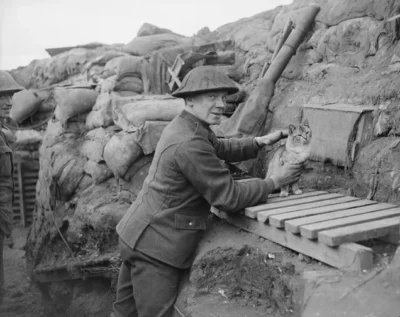
An estimated 500,000 cats became wartime draftees, dispatched to serve in the trenches as rodent controllers or aboard ships, serving the same purpose. At sea, the cat had the run of the ship. In the trenches, they destroyed harmful vermin who ate food or harassed soldiers assigned there.
Aboard ships, not only did the cats save the food supply, but their “work” helped stop the spread of disease or the destructive behavior of chewing through ropes needed in the ship’s rigging. The superstitious sailors also believed that cats protected them and brought them good luck.
Many cats became stars when they served on ships of war. One was Simon, Chief Mouser aboard the British warship, Amethyst. When the ship got trapped on the Yangtse river in 1949, during China’s civil war, Simon was wounded in the shelling of the ship by communist rebels.
However, Simon recovered sufficiently to return to his Chief Mouser job and morale-booster for the crew. He earned the position of “Able Seacat”, becoming famous on his return to Britain. He became the only cat to win the Dickin Medal for animals that show “conspicuous gallantry or devotion to duty”
On the Western front during WW1, the trenches had a serious problem with rats. Of course, the rats smelled food, or even worse, decaying bodies, and gathered at the sources of these odors. The cats eliminated unknown numbers of these vermin.
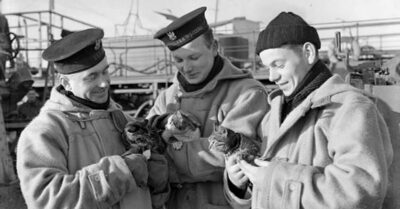
By doing so, the cat also helped lessen the danger of disease brought about because of the rats. Having a cat to destroy these rodents seemed a much tidier and more efficient way to dispose of them, than by spearing them with bayonets. The cat surely removed far more of these vermin than could be accomplished by any other means.
They also performed another important service — they served as morale boosters to men in the midst of war and far from home and loved ones. Their purrs, soft fur, and affectionate ways must have seemed special treasures to the men beside them who became their friends
In fact, consider a young man in a war setting, serving his duty somewhere far from home and loved ones. Of course, he wanted fervently to return there, and the cat became a reminder of peace and home. The cat served as a symol of normality, and all the soldier valued.
Interesting, that my research on this subject received its inspiration from the story of Pitouchi that appeared in my last post. However, when I researched the topic, I found nothing at all about the cat and the village of Verdun. Instead, more than one source gave an entirely different story.
Pitouchi was born in the trenches. When just a kitten, he lost his mother as a tragedy of war. He was adopted and nursed to health by a soldier from the the Belgian army, a Lieutenant Lekeux. The cat followed the officer everywhere he went, and one day saved his life.
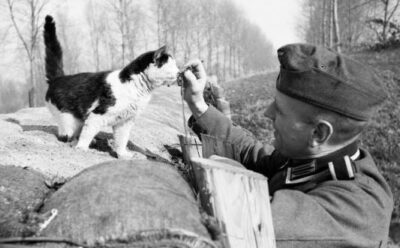
Lekeux, at a spot near the German lines, saw they dug a new trench. Hiding in a shell hole nearby, he made a sketch of the German project. Becoming absorbed in his sketch, he did not see German soldiers approaching on patrol. Finally, he realized his danger, but it was too late to run.
Though he lay very still, he heard one soldier say, “He’s in the hole,” so he knew they had seen him. Pitouchi, hearing the German speak, jumped out of the hole onto a piece of timber. Startled, the Germans fired at the cat, but missed, and the frightened cat jumped back in the hole.
The Germans laughed and joked, thinking they had mistaken a cat for a man. Then they left. Lekeux finished his drawings and returned to the Belgian lines. Pitouchi rode on his shoulder. Thus, the cat saved the life of his beloved companion.
A sad but very valuable service became the task of 500 cats drafted by the British, having the job of detecting gas due to the large-scale use of chemical warfare. If the cat detected the smell of gas, just as the canary in the coal mine who perished due to insufficient oxygen, the cat, much more sensitive than a human, succumbed.
At least his death must not have caused much suffering, and his sacrifice saved the lives of countless humans who could not detect the smell. Let’s face it — war is hell, no matter how we look at it. The cat gave his life to serve, and deserves great commendation for his action.
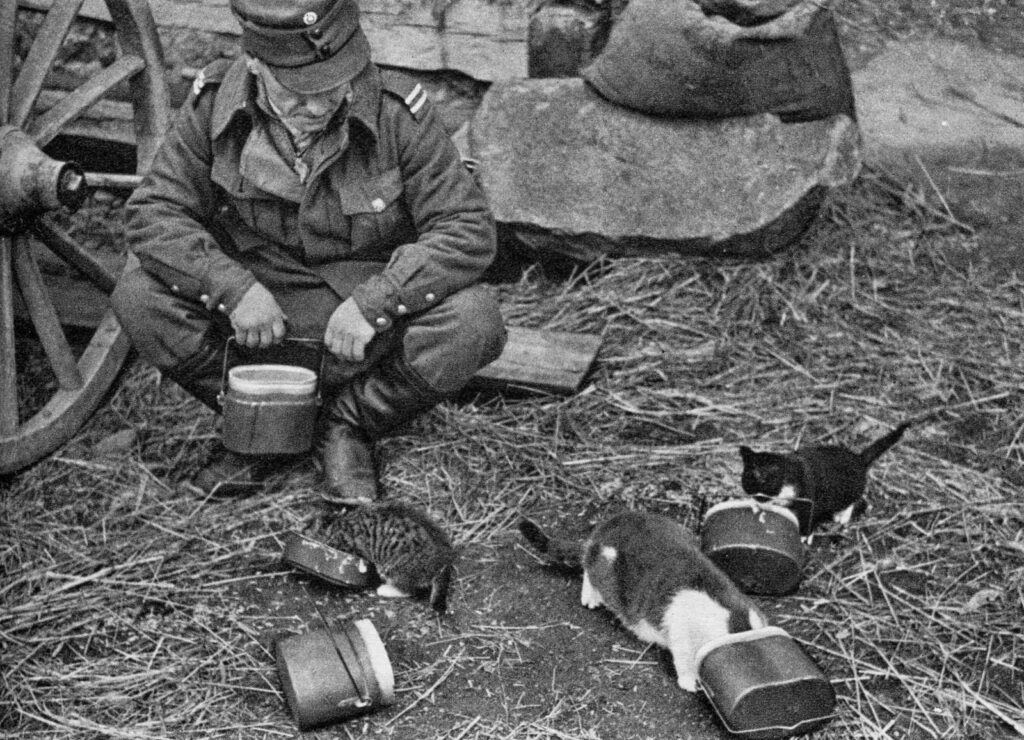
Cats often became mascots for their unit, and became spoiled, fed, and loved by the men who served with them. They received and gave love, an uncommon element during a time of war. We can consider these cats the unsung heroes of wartime, as few even know of their service.
Yet they played an honorable role, saved lives, brought joy at a time when that commodity became very hard to find, and deserve recognition for the service they gave. Though their service would come as a surprise to many, they gave, willingly and freely, and became an important part of the war effort. They did their part to help lead Allied forces to victory at the end of World War 1.
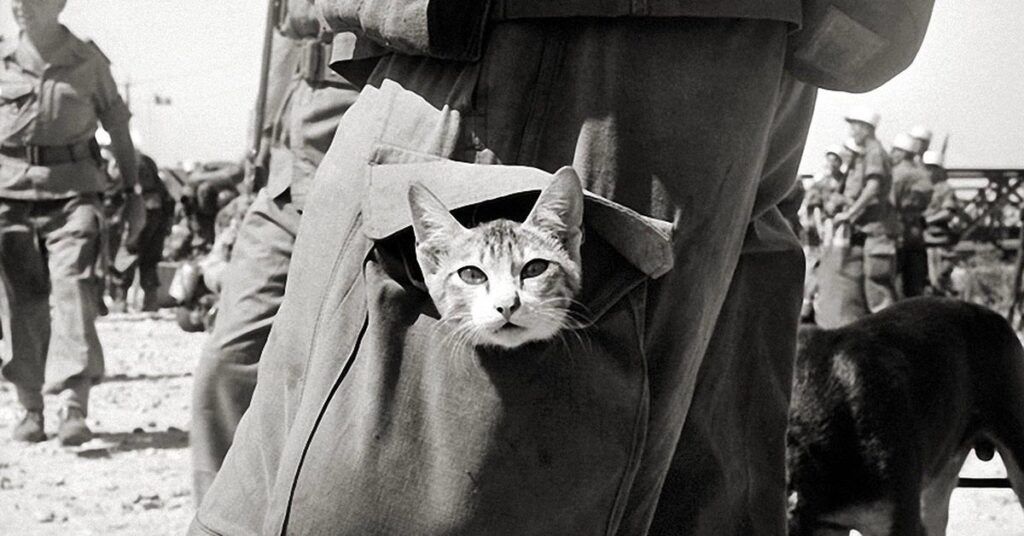
References I used for this post:
stuff.co.nz/life-style/four-legs-good/91888755/how-cats-played-a-key-wartime-role gizmodo.com/a-gallery-of-cats-who-served-in-world-war-i-1624713212 missmollysays.com/cats-and-war-little-known-military-use-felines-ww1/ wearethemighty.com/mighty-history/cats-wwi-trench-companion/ petful.com/behaviors/cats-world-war/

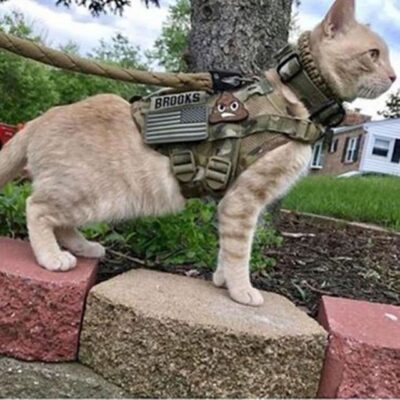
What a lovely article. I knew there were SOME cats in war times, but didn’t realize so many were actually SENT to the war zones. Wonder why this isn’t more widely known information. Thank you for your article.
I learned some things, too…found it interesting. I’ll now research WW11 to see if cats were used there.